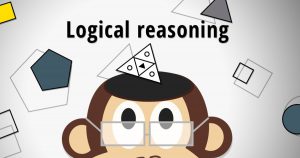Tips to improve your Logical Reasoning skills
Tips to improve your Logical Reasoning skills
Logical Reasoning has a weightage of approximately 16 questions. It is the 2nd section in the CAT exam consisting of 32 questions with Logical Reasoning 16 questions and Data Interpretation 16 questions.
To attain a high score in logical reasoning tests it is essential to undertake an effective course of preparation. Here are some tips to improve your Logical Reasoning Skills.
Join our courses for preparation with experts

- Study the question carefully
Thoroughly read the question. You’ll have to measure every word in the question. You must avoid reading questions too quickly and gloss over details which may cause the majority of errors.
Read both the factual passage and the sentence completion instructions carefully. Both must be considered in making your choice. Be sure to read all the response choices carefully before choosing one.
- Practice relevant questions
Remember practice makes a man perfect. The more you prepare, the better your score will be. A continuous study over a long period of time will enable you to think clearly and you will be halfway to reveal patterns that will lead you to correct answers. Look for a brief explanation of why each choice is correct or incorrect after each practice question. If you understand the reasoning during your practice sessions, the actual assessment would be a cakewalk.
- Know the question type
After long sessions of practicing various types of Logical Reasoning questions, you should be able to identify the different kinds of Logical Reasoning questions. The first step to solving a Logical Reasoning question would be to identify the type. This will help in using the various methods, short cuts, and techniques that you have adopted while practicing the questions and thus help to solve questions faster.
- Become familiar with test shapes
While solving Logical Reasoning questions, the less experienced may get confused by the strange-looking shapes or symbols and thus spend time to figure the questions leading to failure of answering the questions within the time provided. Conversely, individuals who have taken practice tests prior to taking the real assessment can benefit from acquired test-taking tactics. Remember, you are likely to work out a logical reasoning problem much more quickly if a systematic course of preparation takes place. The more practice you do the more speedily you will be able to search for rules, short-cuts, and techniques that describe the transformations of one item into another.
Also read: CAT Preparation: The Do’s and Don’ts
- Simplify the data
A good reasoning question will not have clearly visible useful information. It will be a game where you need to find the information that is required to go ahead. Read the full question and try to filter the important data for the solution. This will require reading the question more than once and each time you will be able to add some more information. Use that information to solve your question efficiently. When you have all the data you need, you will be able to solve the question smoothly.
- Approach the sequence in a systematic way
To improve your logical reasoning skills, try to approach questions in a constructive and methodical way. For example for the Tile question, firstly, attempt to mentally encode items in the series. That is, mentally list the attributes of each shape, sign, or symbol. Secondly, infer the relation between items by listing the transformations that must be performed on items of the first tile to turn items to other items in the second tile. Map the relations between all symbols in the sequence and apply transformations. Further, consider whether shapes or lines move in one direction or the other. Don’t be discouraged by the strange-looking symbols and figures. Try to inspect closely all of the items in the tile and think of how the pattern might work. To improve your skills for logical reasoning practice many puzzles that contain diagrams, symbols signs, or shapes.
Also read: Secret to crack Logical Reasoning
- Diagram wherever possible
Many Logical Reasoning questions have to do with permutations and combinations, ratios, etc. This means that sketches, diagrams, tree diagrams are your new best friends in this section. You will also encounter questions that are swamped with information which is confusing. To make it simple and to handle the question in an efficient way, put all the information in tabular form, bar graph, pie chart, Venn Diagrams, or any other form that you are comfortable with depending on the type of question. When you are practicing Logical Reasoning drills or the section in the mock exam, identify what kinds of diagrams you could use for each question and use the same for the main exam. Look back at the previously solved Logical Reasoning questions that you have attempted and check out the notes you wrote while doing them. Create new diagrams and solve the problem again, which will help you to get comfortable with diagramming. Diagrams will enable you to get a clear perspective of the data and how to proceed with answering it.
Related Articles:













